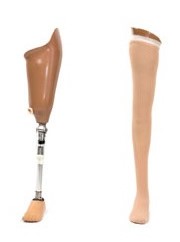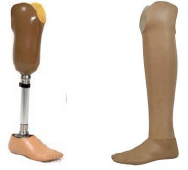Download and print as a PDF (200kB pdf)
On this page
1. What level would the amputation be?
The amputation level is usually decided by the surgeon based upon the likelihood of wound healing. It may be below the knee, through the knee or above the knee.
The amputated limb is called a residual limb or ‘stump’.
2. What can I expect soon after the amputation?
There will be a hospital team comprising of doctors, nurses, physiotherapists and occupational therapists (OT) looking after you.
The physiotherapist will guide you with your transfers and provide you with exercises.
The OT will check how you are managing your daily activities, order a wheelchair or any equipment that you need to discharge home and perhaps undertake a home visit to ensure you can safely manage at home on discharge.
You may be referred to a social worker should you require support at home.
In the immediate post-operative period, you may experience pain from the surgery. This will be controlled with pain killers.
There could be delay in wound healing and sometimes infection which requires antibiotics or other interventions.
The stump will be swollen, and you will be given an elasticated stocking (Juzo) to wear to try to reduce the swelling.
Phantom limb sensation:
A significant proportion of people (approximately 80%) experience phantom limb sensation, which is the sensation of the amputated limb still being there. It usually improves overtime.
Phantom limb pain:
This is also common following an amputation. It is an unpleasant sensation which could be in the form of tingling, burning, cramps etc. Some movements or activities could trigger the pain. The mechanism of phantom pain is not fully understood. Different medications such as pain killers, anti-epilepsy medications can be tried to manage the pain. Although in the vast majority the pain resolves or is manageable, a small proportion will be left with chronic, unremitting pain.
The hospital team on discharge will do onward referrals to the Prosthetic centre and your local community amputee physiotherapist.
Once a referral is received, you can expect an appointment letter to be seen in the Prosthetic centre in due course.
3. What can you expect in terms of prosthetic rehab?
In the community, you will be assessed by an amputee physio who will ensure you are carrying out the recommended exercises. Once the wound has healed, you will be trialled with an early mobilisation aid called PPAMAID (Pneumatic post amputation mobility aid). This will give an indication of your ability to walk with a prosthesis (artificial leg). Your physio will advise you regarding correct positioning of the stump to prevent complications such as development of contractures, which could impact on prosthetic mobility.
It is not advisable to mobilise with crutches as the risk of falls is high.
When you arrive at the Prosthetic centre for your first appointment you will be seen by a multidisciplinary team comprising of a consultant in rehab medicine, nurse, health care assistant, prosthetists (the person who will make and fit the artificial limb), physiotherapist, OT. The goal is to provide you with high quality, patient centred care based on your ability and need.
You may experience different emotions following the amputation such as fear, anxiety and grief. This is extremely common. Our counsellor might be able to support you with this.
We offer a buddy system, where you will have an opportunity to speak to someone who has had a similar level of amputation.
Prosthetic mobility
This depends upon several factors including pre amputation mobility, level of fitness, amputation level, cognition (thinking skills) and other medical conditions such as COPD, angina, heart failure etc. A certain level of cognitive ability is required to use prosthesis safely. OT might carry out a cognitive screening if indicated.
In order to mobilise with a prosthesis, there is considerable energy expenditure, which depends upon level of amputation. There is more energy requirement with ascending levels of amputation. For example, with a below knee prosthesis it is 30-35% above baseline and with an above knee it can be 70%. This will have an impact on your breathing and heart.
Occasionally a below knee prosthesis might be provided to be used primarily for transfers even if the person lacks the ability to mobilise with a prosthesis. Not everyone can mobilise with prosthesis.
Some common issues faced by amputees
The stump volume and shape can change up to 18 months post amputation. You need to bear in mind that it is common to experience skin problems such as ulcers, blisters and infections. If this happens you must cease limb wearing and contact us.
Stump pain can be due to a ‘neuroma’, which is the formation of a nerve bundle at the cut end of the nerve. This can give rise to painful sensations. New techniques such as Targeted muscle re innervation (TMR) are often successful.
You will continue requiring appointments with the prosthetic centre throughout the time of wearing a limb. However, appointments will become less frequent as you become established with a prosthetic limb.
Prosthetic components
The socket is the interface between the prosthetic limb and the stump. A plaster mould of the stump is usually taken to manufacture the socket.
A suspension system attaches the prosthesis to the stump and keeps it in place. Examples include straps, silicon pins etc.
Artificial Joints are usually made of metal and are designed to replicate the functions of real joints such as knee, ankle. There are different types and you will be provided with joints that are most appropriate for your requirements. There are weight limits to these.
A pylon is a metal rod which replicates the functions of the long bones in the leg, such as the shin
Prosthetic foot replicates some of the functions of the real foot. However, they do not mimic all the functions of a real foot, and most prosthetic feet have less range of motion in comparison.


4. Can I have a shower or go swimming?
Your normal walking leg is not waterproof. However, once your stump volume has stabilised, we can consider making a waterproof leg for you.
This information is intended for patients receiving care in Brighton & Hove or Haywards Heath.
The information here is for guidance purposes only and is in no way intended to replace professional clinical advice by a qualified practitioner.